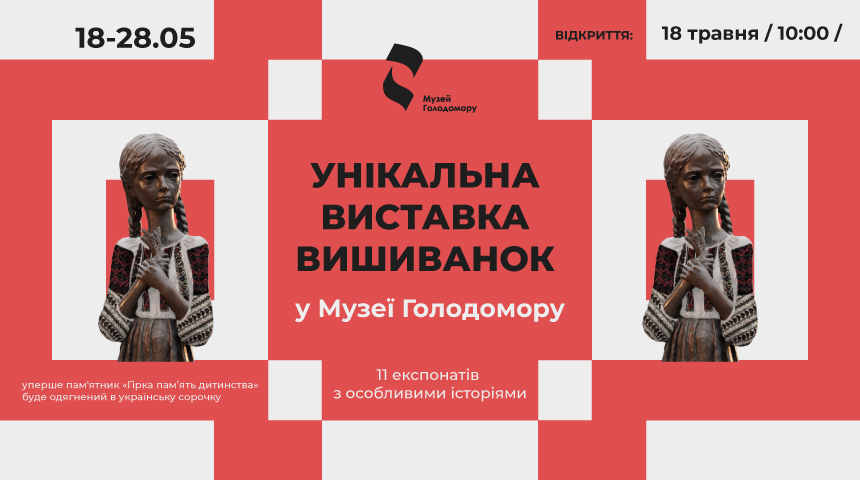A unique exhibition of embroideries from the funds of the Holodomor Museum | May 18-28
On May 18, we invite you to the National Museum of the Holodomor-genocide to celebrate Vyshyvanka Day and International Museum Day together. This year, we combine tradition and modernity to attract the general public to the popularization and study of Ukrainian identity.
![]() For Vyshyvanka Day, for the first time, the most famous monument of the Holodomor – “Bitter Memory of Childhood” (girl with ears of grain) – will be dressed in a Ukrainian shirt. During the Holodomor, Ukrainian children were deprived of not only a piece of bread but a happy childhood too – entertainment, beautiful clothes, carefree everyday life and holidays. On Vyshyvanka Day, with this symbolic action, we want to remember their lost childhood, and remind everyone that it is being stolen from modern children even today, just at this very time, depriving them of the right to safety, education, and often life.
For Vyshyvanka Day, for the first time, the most famous monument of the Holodomor – “Bitter Memory of Childhood” (girl with ears of grain) – will be dressed in a Ukrainian shirt. During the Holodomor, Ukrainian children were deprived of not only a piece of bread but a happy childhood too – entertainment, beautiful clothes, carefree everyday life and holidays. On Vyshyvanka Day, with this symbolic action, we want to remember their lost childhood, and remind everyone that it is being stolen from modern children even today, just at this very time, depriving them of the right to safety, education, and often life.
The shirt that our girl with ears of grain will “wear” was not chosen by chance – it was sewn by the I TELL YOU ethnic clothing workshop from the city of Irpin. The initiative, headed by Yulia Livinska, teaches anyone who wants to quickly and qualitatively make their own embroidery, a symbol of Ukrainian identity and culture. Thus, in addition to participating in Vyshyvanka Day, the Museum expresses its support for grassroots initiatives regarding the modern revival of Ukrainian culture. It is especially crucial for us that the organisers of the initiative carry out their activities in Irpin, contributing to the reconstruction of the city’s public life, which survived the occupation last year.
![]() The campaign starts at 10:00 a.m. near the monument (Kyiv, 3 Lavrska Street).
The campaign starts at 10:00 a.m. near the monument (Kyiv, 3 Lavrska Street).
OPENING AND THE FIRST DAY OF THE EXHIBITION (May 18), DUE TO MUSEUM DAY, ADMISSION IS FREE!
At the same time, an exhibition of shirts from the Museum’s funds with unique stories will open in the Hall of Memory. In particular, embroidered artefacts from the Holodomor period will be presented. One of the most valuable exhibits is a shirt from Perekopivka village, Romny district, Sumy region. Agafia Chub embroidered it in the 1920s for her wedding. The woman died suddenly in 1930. Saving two daughters during the Holodomor, Agafia’s husband exchanged all embroidered items and valuables for food. He left only the wedding shirt of his wife, whom he loved very much. A few years ago, the daughter of the late Hanna Avramivna Omelianenko (Chub) donated a family heirloom to the Holodomor Museum.
The exhibition will also feature unique shirts that were found in Yerkivtsi village, Boryspil District, Kyiv region. The donator, Daria Anishchuk, and her husband are doctors and got a job in a rural outpatient clinic. The village council provided them with a house for temporary residence. It was there that the new owners found four embroidered shirts that could have ended up in the garbage but were “rescued” and given to the funds of the Holodomor Museum.
“Now, when the Russians are destroying our history, we have no right to do it with our own hands. And these shirts are part of our history,” Daria Anishchuk commented herself.
![]() In general, from May 18 to 28, the Museum will present 11 embroidered shirts, most of which have a unique history.
In general, from May 18 to 28, the Museum will present 11 embroidered shirts, most of which have a unique history.
We also invite media representatives! The Museum staff, scholars and workers of the Foundations are ready to give comments for journalists.
